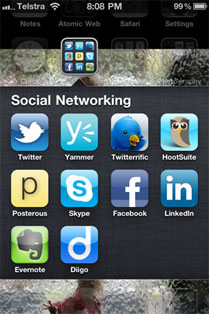As part of a book group at work we’ve been reading Clay Shirkey’s: Here Comes Everybody: The Power of Organising Without Organisations, and I thought I’d share this reflection of the power of crowds, or the flash mob and social media. The recent story about Caine’s Arcade is a great example of networks, connections and social media amplifying a story and making a difference. A difference that would be worth making to all those other stories like Caine’s that we don’t hear about.
Recently I followed a link in a tweet to a video by Nirvan Mullick that has gone viral and had nearly 5 million views on Youtube & Vimeo in about a week. Caine’s Arcade is a heart warming story of a 9 year old boy in Los Angeles who build his own (slot machine) arcade out of cardboard and packing tap over the summer holidays. The video is well edited and a nicely paced story told an appropriate 11 minute package.
Caine displays lots of imagination, creativity, motivation and entrepreneurial spirit while remaining matter of fact sort of kid. The story of the arcade he designed and built provides a great example of what the outcome of good learning (mostly self-taught?) can be. The unique conditions in which he created the arcade (in front of the counter at his father’s car used auto-parts business) might not be what we’d think of as an ideal learning environment, it worked for Caine and was most suitable in this instance. I’d love to see more of this sort of thing being constructed in school classrooms.
Watch the video out on Youtube
Other than TV coverage there’s been some commentary about why this story might appeal, what might happen to Caine, and what makes a viral video.
But wait, there’s more – a teacher has developed a lesson plan based around the story, there’s the Facebook page, and the Caine’s Arcade foundation has been set up to raise funds for an education scholarship.
I found some comments in this article highlighting the amount of money raised by Caine’s Arcade foundation interesting when it suggested that: “Crowd-sourcing the funding of Monroy’s college education is great. But this is only helping one child and it isn’t sustainable,” says Gordon Coonfield, a professor of communication at Villanova University in Philadelphia. “We need to find more sustainable and broader-reaching ways to help those who need help. Maybe crowd-sourcing and social networks are something the nonprofit sector and education institutions need to take a closer look at.”
I believe there’s also a responsibility for those who use the tools and power afforded by social media, to be aware of the potential for collateral damage. Remember Star Wars Kid? – see Wikipedia and Know your meme. While young Caine didn’t have much control over what’s happened to him and seems to coping with the new found fame, I hope he’s able to get back to what we might think of a normal life soon.
But back to Shirky’s book and linking the ideas of the power of social media to organise groups and how this might be used in education/learning. The affordances of social media provides groups with efficiencies and a new capacity for ‘sharing, cooperation and collective action’. As we come to understand these new ‘tools of culture’ and as their design, functionality, and our access to them evolves, we need to think carefully about their use and understand the ramifications of the affects that they will have on all aspects of our lives.
What does the power of social media and the willingness of people to engage & connect this way mean for us in higher education?
How does the possibility of these connections and collaborations affect our work in teaching and research?
Are particular (digital) literacies required to use social media meaningfully & responsibly?
Where is the place for ‘analogue’ means of connection as social media becomes a more ubiquitous tool of modern culture?
PS. Danah Boyd has just published a piece in The Guardian called, Whether the digital era improves society is up to its users – that’s us, and discusses concepts such as the attention economy and radical transparency. The byline for the article is, “Social media in particular has inexorably changed the world, driving openness and fear – but it is not beyond our control”. An intersting read.

